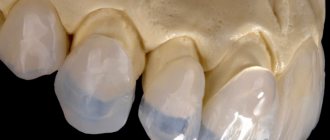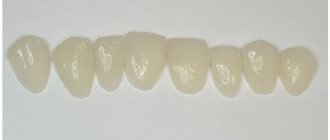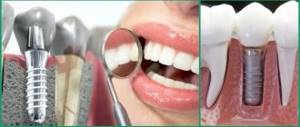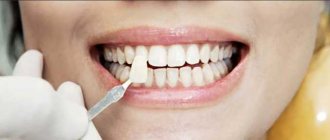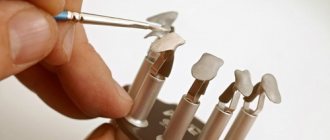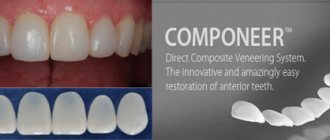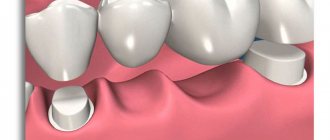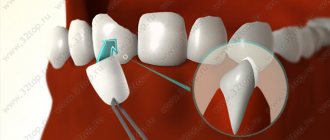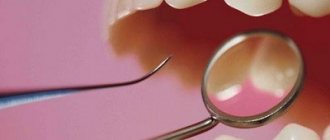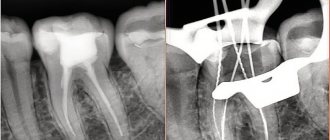1426
Today, the problem of unhealthy and unattractive teeth in the smile area can be overcome with the help of veneering.
The procedure involves installing thin plates on the teeth, which mask minor defects in the frontal region and improve aesthetics.
Before fixing the veneers, it is important to prepare the problematic units. This is the only way to avoid unpleasant sensations of foreignness in the oral cavity and reduce the risk of damage to the thinnest artificial element.
A little about the procedure
Enamel preparation (turning) is an important condition for aesthetic prosthetics, ensuring reliable connection of the veneer or other prostheses with the hard tissues of the tooth.
During orthopedic treatment, specialists often perform enamel grinding. This pre-treatment ensures reliable fixation of the prosthesis with the outer shell of the tooth and proper tightness.
Previously, such manipulation caused pain and discomfort to patients, so many tried to avoid it. Today, the preparation procedure is a minimally invasive treatment of enamel, performed using high-tech equipment without pain.
Benefits of the procedure:
- high-quality veneer fixation;
- maximum increase in product service life;
- masking connecting points.
Despite a number of advantages, some clients of dental clinics try to do without grinding before installing veneers. However, it is not possible to completely avoid preparation.
This type of restoration requires increased quality of contact between the plate and the tooth surface. The protective layer is never perfectly smooth - it contains tubercles, grooves, and depressions.
If the veneer does not adhere tightly to such a surface, pathogenic microorganisms will multiply intensively in the natural fissures.
In addition, the enamel is ground down to reduce the overall thickness of the tooth. After all, if you do not first prepare and apply the plate, the unit will become bulkier and not aesthetically massive, worsening the beauty of the smile and disrupting the functionality of the entire jaw apparatus.
Also, the tooth must be prepared in the presence of large-scale carious lesions. They must be eliminated to protect them from further damage under the plate.
In some cases, when fixing aesthetic plates, the doctor does not touch the enamel. For example, preparation is abandoned in case of installation of direct veneers made from a composite composition.
With such a correction, the doctor layers a special correction material on the outer surface of the element. The patient will need one visit to the dentist for restoration. However, composite veneers, installed without removing the hard tissues of the tooth and leveling its surface, are used quite rarely in orthopedic practice.
When installing ceramic veneers made individually in a technical laboratory, it is important to ensure a strong and reliable fit of the plate to the enamel. Therefore, grinding down solid structures to plate thickness is a necessity in this case.
Grinding can harm high-quality veneering in the following exceptional cases:
- pathological abrasion of enamel was diagnosed;
- the front surface is insufficiently thick;
- the cutting edge of the unit has irregularities;
- visual camouflage of the turn is planned.
Remember! If the enamel is affected by caries, then it must be removed before installing veneers. Moreover, it does not matter what type of plates are supposed to be installed, be it ceramic, composite or porcelain products. It is impossible to leave a pathological lesion under a microprosthesis.
In rare cases, for example, when restoring hard tissues of the tooth wall, the grinding procedure is not carried out. The specialist simply makes the front side of the protective layer slightly rough, which helps improve the adhesion of the orthopedic product to the restored surface.
How to understand what color of veneers to choose, and what factors are important to consider.
Come here if you are interested in the rules for caring for veneers.
At this address https://www.vash-dentist.ru/protezirovanie/nesemnyie-p/viniryi-np/ulyibki-s-pomoshhyu-snap-on-smile.html you will find real reviews about Snap on Smile veneers.
Zirconium dioxide veneers –
Zirconium veneers are the most durable. If the veneers are made of opaque zirconium dioxide, their bending strength will be about 900 MPa, and if they are made of translucent zirconium dioxide, they will be about 550 MPa (which is also very high). This certainly eliminates the risk of porcelain chipping if the veneers are made from monolithic zirconium dioxide rather than by applying porcelain to a milled zirconium frame. But when it comes to aesthetics, zirconium veneers are inferior to both feldspathic ceramics and E.max glass ceramics.
Zirconium veneers: before and after photos
Problems with aesthetics are related to the characteristics of the material. The fact is that most dental clinics purchase so-called “raw” “soft” zirconium dioxide (it has a low price). And because Since this material is soft, it allows the clinic to save a lot of money - also on the need to change cutters for milling zirconium blocks less often. The problem is that this cheap zirconia is bright white and lacks translucency, so veneers made from this material will not be very aesthetically pleasing.
Important: however, there are also more expensive zirconia blocks - pre-colored / translucent (the latter thanks to the addition of yttrium), which allow you to make veneers of almost the same quality as veneers made from E.max PRESS pressed ceramic. Such materials include -
- the best option is the Katana® UTML material (Japan) - zirconium veneers from this material are practically not inferior to veneers from E.max PRESS,
- slightly more modest options are Katana® STML (Japan) or Prettau® Anterior (Germany) materials.
How much does it cost to install zirconium veneers?
The cost of veneers for front teeth made of good quality zirconium dioxide should be about 30,000 rubles (for 1 unit), plus or minus several thousand rubles. However, when using so-called “raw” zirconium dioxide, the minimum price we fixed in Moscow was 12,000 rubles, which is due to the low cost of such material.
Zirconium veneers on teeth (video 3) –
In the video above you can see that initially there are old, but still good fillings on the upper central incisors. Obviously, the doctor who posted this video is proud of the result, but let’s take a closer look at the manufactured veneers... It’s immediately clear that the so-called “body” of the veneers (in the middle third, as well as in the third closest to the gum) is too massive and absolutely opaque. And that is why these expensive zirconium veneers look more like cheap metal ceramics.
Secondly, the contrasting zone where the veneer transitions into the gum immediately catches your eye. And again, these look like cheap crowns. Therefore, we once again recommend that if you decide to make veneers from zirconium, then make them from a translucent material, for example, Katana® UTML (Japan). True, for this you will have to try hard, finding out exactly what they do in each clinic, and hope that you will not be deceived.
Disadvantages of fixation without turning
A qualified dentist who values his reputation will never install veneers without grinding if he considers this procedure necessary for a high-quality restoration.
To achieve the desired effect, the patient must trust the specialist. In case of incorrect installation of a plate on a solid tooth, the following consequences are possible:
- Dark spots on the enamel will be visible through the corrective fixed structure. Lumineers, the thinnest porcelain linings, are especially distinguished by their ability to shine through. So even for them it is often necessary to prepare the enamel.
- A tooth with a fixed plate will look bulky . If the layer of hard tissue is not removed from the unit, after installing the veneer it will appear voluminous and unnatural. In some cases, lack of preparation becomes a consequence of impaired articulation and chewing processes.
- Without grinding down the tissue, after fixing the plate in the gum area, a ledge is formed , which becomes an ideal place for bacteria to colonize. In such depressions, pathogenic microflora develops rapidly, promoting the dissolution of minerals and further destruction.
Many patients, after reading advertising articles, mistakenly believe that veneers can be removed from unground enamel without consequences for the appearance of the teeth. This statement should not be considered correct.
Ceramic veneers, which are most often used in restorative dental work, are sufficiently thick, so in all cases they require preliminary grinding of the tissue. The exception is ultra-thin veneers and lumineers from American manufacturers.
Veneers for front teeth - indications for use
Veneers cannot be made on all teeth, but only on the 10 upper front teeth, as well as the 8 lower front teeth. These limitations are associated with too high a chewing load in the area of large chewing teeth. Veneers on the front teeth can correct:
- chipping of the cutting edge (Fig. 4),
- unattractive tooth color that cannot be improved by chemical whitening (Fig. 5),
- the shape of the teeth is not beautiful enough,
- spaces between teeth (Fig. 6),
- moderate crooked teeth that you want to correct without orthodontic intervention.
Ceramic veneers: before and after photos
Techniques used
When performing prosthetics with veneers, dentists everywhere use a number of effective and practice-tested techniques. Innovative devices and devices are successfully combined in tandem with standard grinding methods using a drill. The choice of procedure technique depends on the condition of the patient’s teeth and the specifics of the doctor’s work.
Before starting preparation, the dentist must assess the condition of the gums and determine the depth of the root and pulp.
All existing stitching techniques are presented below.
Laser method
New trends and technologies have made it possible to use laser more often in dental practice and beyond. The use of this device allows the doctor to perform a minimally invasive procedure without pain and in conditions that are safe for the patient’s health.
Algorithm of laser action when preparing teeth:
- after switching on, the laser pulse mode starts;
- every second the device sends out an average of 10 rays, each of which carries a certain amount of energy;
- hitting hard tissue, the impulse evaporates a thin layer of bone mass.
In other words, under the action of the laser and heat, a microexplosion occurs on the surface of the enamel, which throws out dentin particles. You can remove them from the oral cavity using a water-air stream.
Due to the fact that the tooth does not heat up much during the procedure, and the doctor does not use a mechanical drill, irritation of the nerve endings is excluded, which means there is no pain.
The main advantages of the installation are the ease of its use, the ability to fully control its operation, the accuracy and safety of the procedure.
Experts also include the following advantages of the method:
- absence of cracks and chips in the enamel after laser treatment (they always form after the use of a bur);
- sterility of the surface prepared in this way (the laser destroys any pathogenic microflora);
- the ability to grind down large areas of dentin at one time.
Remarkable! To work with a laser, the dentist must have sufficient experience and proper qualifications.
Ultrasonic
This technique involves the use of a special tool that distributes high-frequency vibrations. More often, specialists use special nozzles and ultrasonic tips, the working area of which is diamond coated.
The essence of the tool’s operation is that the attachment makes microscopic vibrating movements in a circular motion along the surface of the tooth.
Ultrasonic equipment speeds up dental interventions and minimizes the risk of injury, and also helps improve the quality of restorations of any complexity.
Advantages of turning with an ultrasonic device:
- minimum pressure of the nozzle on the tissue;
- painlessness of the procedure;
- no risk of significant heating of enamel and dentin;
- formation of chips on the coronal part is excluded;
- no negative impact on the pulp structure.
It is important! Ultrasound is contraindicated for use in patients with hemophilia, pacemakers in the body, as well as children and pregnant women.
Chemical
With this technique, the dentist uses chemical materials in his work. They slowly soften the tissue in certain areas, making it easy to remove the desired layer.
A significant disadvantage of this procedure is its duration. To activate the reagents, the patient will have to sit in the dental chair for about 30 minutes.
The undeniable advantages include:
- absence of pain, dentin overheating and trauma;
- The possibility of fragmentary damage to the relief of the protective layer of the tooth is excluded.
Tunnel
Preparation by this method involves the use of a turbine unit with variable speed control. The specialist places a diamond or metal tip on the device.
It is worth noting that old and worn-out equipment is not suitable for high-quality preparation for veneers, because Due to overheating of hard tissues, there is a risk of complete tooth destruction.
When using the tunnel grinding method, the dentist tries to remove a small layer of tissue. Moreover, he can control the removal process and the thickness of the liquidated layer.
It is important to highlight the disadvantages of the procedure, and these are:
- pain from overheating of the enamel (occurs when anesthesia is not strong enough);
- high risk of injury to soft structures, especially if the doctor violates the technique of using the boron;
- enamel may split (if old and low-quality equipment is used during the procedure).
Air abrasive
This technique was proposed in the 50s of the last century by Robert Black. The technique is based on cold preparation of enamel and dentin with high air pressure.
During the procedure, a compressed air stream passes through the abrasive compartment. The created suspension of abrasive particles is transferred to the working tip.
It is worth noting that particles with high kinetic energy fly out of the tip at high speed. A very hard abrasive upon contact with the tooth structure destroys surface tissues.
The latest generation devices differ from previous models in that, in addition to aluminum oxide and an air-abrasive flow, they are supplemented with a water spray. Water gives the specialist the opportunity to effectively eliminate destroyed tissue particles and abrasive residues from the oral cavity.
Remarkable! The technique is used to remove exclusively the outer layer of enamel. At the same time, the tissues do not heat up significantly during the procedure.
In what cases is it justified to install zirconium veneers on teeth and the price of the issue.
This publication proposes the characteristics of porcelain feldspathic veneers.
Here https://www.vash-dentist.ru/protezirovanie/nesemnyie-p/viniryi-np/duo-pch-estestvennaya-krasota.html all the most important things about Duo veneers.
Veneers: pros and cons
Below we will give answers to questions that patients often ask when consulting an orthopedic dentist regarding the installation of veneers...
What is better - veneer or crown?
First of all, veneers can be done on any teeth, but with the exception of 6-7-8 chewing teeth. Secondly, they can only be done in the absence of contraindications, which we listed above in this article. If there is at least one contraindication from this list, it is advisable for you to opt for crowns. What to choose - veneers or crowns (in the absence of contraindications), then the best choice is definitely veneers.
For a veneer, the tooth is ground down mainly only from the front surface, which allows you to preserve not only more of the tooth’s own tissues, but also leave the tooth alive. This will certainly increase its service life. Thin veneers require grinding down the enamel by only 0.3 mm, and the tooth for the crown is ground down on all sides by an average of 1.5-2 mm (which makes it look like a stump).
A tooth ground for a metal-ceramic crown –
What is better – veneers or restoration?
Porcelain veneers have a unique property - they are able to completely imitate your own tooth tissue. This happens because both tooth enamel and porcelain are equally translucent and reflect light equally. In healthy teeth, light rays pass through the tooth enamel and are reflected from the denser and darker dentin underlying the enamel.
After reflection, the light rushes back, which gives the enamel a shiny, somewhat glassy appearance. The same thing happens with porcelain veneers: light passing through them is reflected from the darker cement and rushes back. In addition, with the help of special pigments, you can give porcelain any shades that will imitate the color and transparency of neighboring healthy teeth.
But the light-polymer/composite filling material, which is used for restorations, does not have the same characteristics of light transmission and translucency. Therefore, the aesthetics of filled front teeth are very far from ideal, unless, of course, you are really picky about aesthetics. Take a closer look at the restored teeth - they are always grayer and duller than healthy teeth (Fig. 26).
Restorations are not only inferior in aesthetics initially, but they also have the property of darkening over time, and therefore after a few years they usually require replacement. In addition, very often a dark line appears at the tooth/filling border over time (due to the penetration of pigments), which already worsens the aesthetics. But porcelain veneers will not change their color at all even after 20 years.
Stages of implementation
Dentists carry out the procedure in several stages:
- Determining the extent of penetration into the containment structure . To do this, the doctor makes horizontally directed indentations on the front part of the unit. Depth control is carried out using a diamond bur. Treatment is carried out to the gum line, covering the sides.
- Accurate elimination of a thin enamel layer (no more than 1 mm). In case of significant carious lesions, significant intervention in living tissue is allowed. The cutting edge can also be machined.
- Polishing the work area. The specialist carefully grinds the prepared surface, applies a degreaser, washes and dries.
- Etching the surface with a special chemical composition. This preparatory treatment will increase the adhesion of the surface to the product.
In the video, watch the process of classic tooth preparation for veneers.
The nuances of installing ceramic linings
Today, the most popular of all existing types of veneers are ceramic plates.
The silicon oxide from which the products are made is characterized by high strength and high light transmittance , which brings the properties of the material as close as possible to those of natural enamel. This allows porcelain veneers to be identical in appearance to natural units.
Doctors consider the main advantages of these products to be resistance to dyes, acidic environments, and a longer service life than composite linings.
There is no uniform technique for turning enamel for installing ceramic plates. Dentists take an individual approach to this procedure.
The choice of the optimal method will depend on the following factors:
- type of veneer;
- location in the jaw arch;
- condition of hard tissues and the presence of carious lesions;
- the extent of previous restoration work using filling material.
Dentists often make medical errors during the veneering process. Basically, the poor aesthetics of the installed plates is due to improper grinding of the enamel layer. Reducing the overall thickness is carried out in two ways. Below we will look at them in more detail.
Indirect method
The method is complex, but allows you to get strong, beautiful and healthy teeth.
Algorithm for installation manipulations:
- a thin layer of enamel is removed from the teeth;
- chips and edge lines are processed;
- Using a special impression mass, an impression is taken from each unit;
- a three-dimensional model of the jaw is created with all detected defects;
- the patient is provided with temporary plastic plates for the period of production of permanent products (up to 14 days);
- re-visiting the patient to remove temporary structures with subsequent installation of microprostheses;
- fixing products to the surface using an adhesive;
- polymerization under a lamp.
Important! Before installing veneers using the indirect method, it is necessary to remove the optimal layer (at the discretion of the doctor). If you make a mistake with the thickness of the tissue being eliminated, there is a risk of creating the effect of horse teeth, when the plate visually increases the volume.
Direct method
This method is indicated when the patient needs to restore the shade of the enamel, mask stains and restore minor chips. The work uses composite material. The main advantage of the direct method is the ability to restore the integrity and aesthetics of the tooth in one visit to the dentist.
The sequence of actions of the dentist when performing the procedure:
- administering local anesthesia to the patient;
- sawing off a thin layer of protective shell;
- alignment of the sides and lower cutting edge;
- degreasing the working surface with a special agent;
- layer-by-layer application of the composite with thorough drying of each stroke;
- grinding the finished crown and forming natural contours.
Final polymerization of the material occurs 2 days after veneering. Until this point, the patient should avoid eating hot and solid foods. It is also important to carefully close your jaws and bite off foods.
Feldspar ceramic veneers −
Dental feldspathic ceramics are also called porcelain. Porcelain was the first material from which veneers were generally made. It allows you to perfectly imitate the optical properties of real tooth enamel - its color and translucency. Porcelain veneers have very good aesthetics - no worse even in comparison with glass-ceramic veneers E.max (24stoma.ru).
Porcelain veneers: before and after photos
Porcelain veneers can be made using three different methods. Firstly, using the method of layer-by-layer application of porcelain mass, which implies that the ceramic mass is applied in layers and also baked in layers at high temperature. Secondly, by injection molding under conditions of high temperature and pressure (this method is preferable to the first, since the veneers will be much stronger).
Thirdly, there is feldspathic ceramics in the form of blocks, which are used for the manufacture of ceramic veneers/crowns using the milling method using a CEREC machine (CAD/CAM technology). An example of such material is “Vita Mark 2” Zahnfabrik, made in Germany.
Porcelain veneers – pros and cons, price
The main advantages are stunning aesthetics and affordable cost. The price for porcelain dental veneers in Moscow and St. Petersburg will be very affordable. For example, in economy class clinics it can start from only 12,000 rubles, and in mid-price clinics it will be about 16,000 rubles. But unfortunately, porcelain veneers also have some minor disadvantages...
For example, the flexural strength of porcelain layered veneers is only 50-75 MPa, which means there is a greater risk of porcelain chipping. When producing porcelain veneers by pressing or using CAD/CAM technology, the bending strength will be about 150 MPa. This is generally sufficient if you have a good bite and will not chew on anything hard. For comparison, veneers made from E.max have a bending strength of 370-400 MPa, but the price is 1.5-2 times higher.
Porcelain veneers before and after (video 1) –
In the video below you can see how amazing veneers on the front teeth made of feldspathic ceramics (porcelain) can look, which are indistinguishable from the most beautiful real teeth.
Reviews
There is no need to be afraid to grind your teeth before installing aesthetic plates. Today, any dental clinic is ready to perform this procedure absolutely painlessly and with respect for the tissues of the oral cavity.
The main thing is to approach responsibly and with care the choice of a truly experienced specialist who will install veneers in a high-quality manner and provide the patient with a “Hollywood” smile.
What do you think about the advisability of preparation before installing veneers? Share your thoughts in the comments below.
If you find an error, please select a piece of text and press Ctrl+Enter.
Tags veneers
Did you like the article? stay tuned
Previous article
Orthodontic adhesive is the best option for fixing braces
Next article
Powerful motivation to install braces
